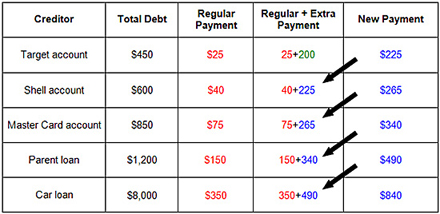Give Debt the Boot
If used properly, credit cards, personal loans and student loans aren’t bad for your credit rating. In fact, making payments on time and keeping your account up-to-date actually improves your score, helping you qualify for more credit and lower interest rates in the future.
What happens when you skip a couple of payments or start making only the minimum payments on your accounts? Debt slowly creeps up on you and, if you’re not careful, it can quickly become a problem!
Not paying back the money you borrowed is like bull riding without a rope! Loans and credit card debt are serious obligations. Late payments are reported to consumer reporting agencies and reflected on your credit report. Defaulting on your loans can lead to many negative consequences, including wage garnishment or even legal action against you. Ouch!
Unfortunately, our credit history isn’t a slate that’s easily wiped clean. Credit mistakes made early in life can follow you for many years. The consequences of poor financial decision-making can seriously affect your lifestyle and career. For example, did you know that many employers and landlords routinely review applicants’ credit reports before making hiring or renting decisions? That’s right - excessive credit card debt or failure to repay a student loan can cost you that dream job or perfect apartment! A poor credit history can also significantly impact your ability to qualify for a mortgage or auto loan when you’re ready to buy your first house or a new car.
This is why it’s important to make every effort possible to pay your bills in a regular, timely manner, and to make more than the minimum monthly payment. If for some reason you’re having trouble meeting your committed repayment schedule, contact your creditor(s) immediately. Most will work with you if you’re serious about staying on track, but you must let them know what’s going on as soon as possible.
If you’re having trouble paying down the debt you’ve already accrued, try the approach that some professionals call the “debt snowball.” Here’s how:
- List your debts in order from smallest to largest with the smallest balance first.
- Next, dedicate a set amount of money to debt removal each month. In the example below, we use $200.
- Then, while still making your regular payments on all other debts, add your extra lump sum to your regular payment for the debt with the lowest balance.
- Repeat this process each month until that debt is paid off, then start again with the next lowest balance, including the amount of your regular payment on the debt you just paid off.
The chart below illustrates this principle. See how quickly payments on your smaller debts will “snowball” to eliminate your large debts.

Download OKMM’s Debt Snowball Worksheet
If your debt has grown into a situation you can no longer handle, talk to someone. Seek the advice of a trusted adult, parent or credit counselor. For more information about credit counseling services, contact a nonprofit provider, such as:
GreenPath Financial Wellness
800-550-1961
www.greenpath.com
National Foundation for Credit Counseling
800-388-2227
www.nfcc.org
